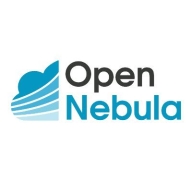


OpenNebula and Nutanix Cloud Clusters are competitive in cloud infrastructure management. While OpenNebula offers cost advantages, Nutanix Cloud Clusters is notable for its superior feature set, making it attractive for enterprises seeking comprehensive solutions.
Features: OpenNebula offers open-source cloud management with flexibility and easy integration with various environments. It supports templates for configurations, multiple hypervisors, and has a stable performance. Nutanix Cloud Clusters provides extensive features such as hybrid cloud support, integrated disaster recovery, and excellent scalability, leveraging enterprise needs with advanced data management and cost control capabilities.
Room for Improvement: OpenNebula could benefit from enhancing customer support services, providing more advanced deployment tools, and expanding its feature set for better competition. Nutanix Cloud Clusters could improve through reduced pricing options, simplifying UI for non-technical users, and expanding native integration options with diverse cloud services.
Ease of Deployment and Customer Service: OpenNebula is simpler to deploy, aimed at organizations favoring straightforward setups, though its customer service is less extensive. Nutanix Cloud Clusters has a more complex deployment process with a focus on automation and robust customer service for seamless operational support.
Pricing and ROI: OpenNebula offers a budget-friendly setup, making it ideal for organizations with budgetary constraints as it provides a good ROI with cost-effective resource management. In contrast, Nutanix Cloud Clusters requires a higher initial investment but assures substantial ROI through its comprehensive features and operational efficiencies, aligning with enterprises seeking high-performance solutions.



IBM Turbonomic offers automation, planning, and right-sizing recommendations to streamline resource management, improve efficiencies, and optimize costs across virtualized environments and cloud platforms.
IBM Turbonomic is valued for its capability to optimize resource allocation and monitor virtual environments efficiently. It facilitates automated decision-making in VM sizing, load balancing, and cost optimization for both on-premises and cloud deployments. Users can leverage insights for workload placement, ensure peak performance assurance, and effectively right-size across VMware and Azure. The ongoing transition to HTML5 aims to improve visual and navigational ease, while expanded reporting features are anticipated. Opportunities for improved training, documentation, and integrations enhance platform usability and functionality.
What Are the Key Features?In finance, IBM Turbonomic aids in maintaining platform efficiency during market fluctuations. Healthcare organizations leverage its capability for resource optimization during high-demand periods to enhance patient care support. Retailers use it for planning in peak seasons, ensuring resources align with fluctuating demand to maintain performance continuity.
Nutanix Cloud Clusters (NC2) provide essential capabilities for managing cloud migration, infrastructure, disaster recovery, and data center replacement. They enable seamless application transfer between cloud and on-premises, ensuring redundancy and handling large-scale operations across multiple locations.
With NC2, users manage server virtualization, web access, and email services while implementing robust failover solutions into public cloud environments like Microsoft Azure and Amazon AWS. The service offers full cloud capability for on-premises applications, strong technical support, and effective integration with existing environments. However, pricing, interface intuitiveness, initial setup, and AI enhancements are areas for improvement. Issues like alert false positives and the cost of necessary blocks and nodes have been noted. Enhanced multi-tenant features, detailed configuration information, and better VM organization are also desired by users.
What are the key features of Nutanix Cloud Clusters (NC2)?Organizations utilize Nutanix Cloud Clusters (NC2) in industries like sports betting, where they manage web access and handle server virtualization. It is also implemented for email services, security measures, and as a failover solution into public cloud environments. The system's flexibility and strong support make it valuable across various large-scale operational needs.
OpenNebula provides the most simple but feature-rich and flexible solution for the comprehensive management of virtualized data centers to enable private, public and hybrid IaaS clouds. OpenNebula interoperability makes cloud an evolution by leveraging existing IT assets, protecting your investments, and avoiding vendor lock-in.
OpenNebula is a turnkey enterprise-ready solution that includes all the features needed to provide an on-premises (private) cloud offering, and to offer public cloud services.
We monitor all Cloud Management reviews to prevent fraudulent reviews and keep review quality high. We do not post reviews by company employees or direct competitors. We validate each review for authenticity via cross-reference with LinkedIn, and personal follow-up with the reviewer when necessary.